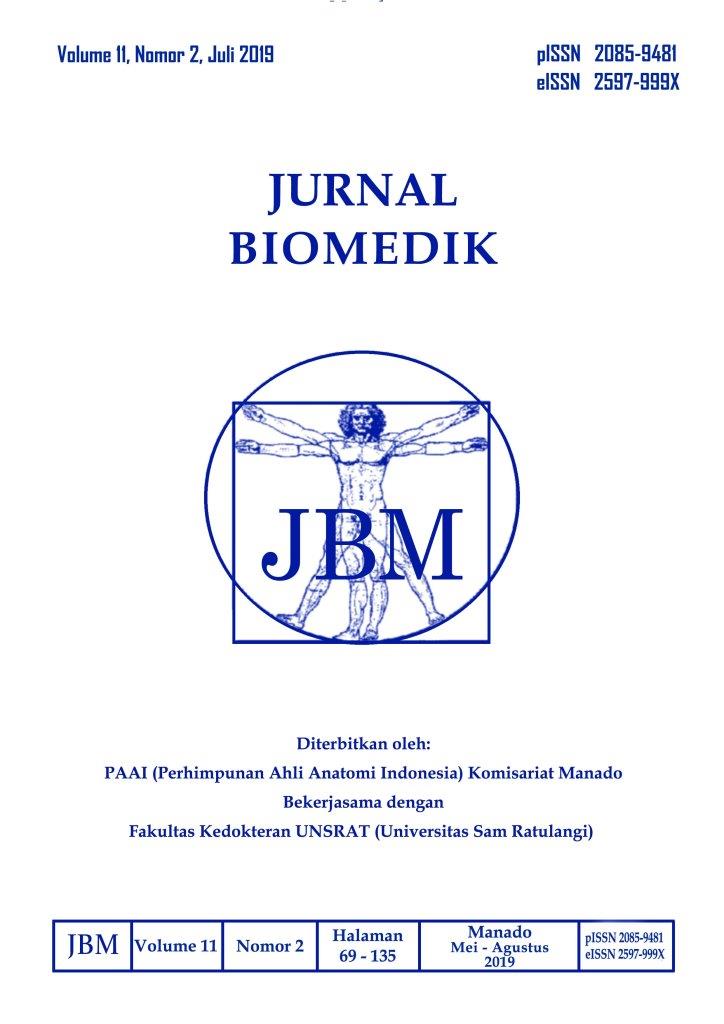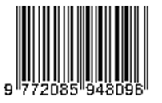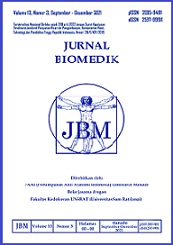Hubungan Kadar Interleukin 10 Serum dan Klasifikasi CT Marshall pada Pasien Cedera Otak Berat akibat Trauma
DOI:
https://doi.org/10.35790/jbm.11.2.2019.23321Abstract
Abstract: Increased level of interleukin 10 (IL 10) in patients with severe traumatic brain injury (TBI) has been documented, yet studies of its ability to predict the outcome based on the Marshall CT classification are still limited and lacks of clarity. This study was aimed to evaluate the relationship between serum level of IL 10 and the Marshall CT classification among patients with severe TBI. This was an analytical observational single-center study with a cross-sectional design. Immediate CT scans were used to determine the Marshall CT classification and to categorize the location (extra-axial, intra-axial, both), hemisphere (midline/diffuse, dextral, sinistral), and area (frontal, parietal, temporal, occipital, multiple) of the injury. Venous blood sample for IL 10 was taken less than 24 hours of trauma in the Intensive Care Unit. Age and gender were also recorded. Variable selection was run in stepwise forward fashion. Proportional odds models were conducted to assess the changes in the Marshall CT classification related to levels of IL 10. There were 25 patients admitted consecutively to the emergency room (ER) with severe TBI included in this study. The results showed that the mean IL 10 was 107.3 pg/ml (SD 16.2 pg/ml). Patients were distributed almost uniformly within four detected categories (diffuse injury II, III, V, and VI) of the CT Marshall classification. Final regression model consisted of IL 10, age, and injury on temporal area as predictors. Controlling for the others, every 10 pg/ml additional of IL 10 increased the odds to higher (worse) categories in the CT Marshall classification by about 1.95 (95% CI 1.16 – 3.30) times. Conclusion: Interleukin 10 is a potential predictor for the CT Marshall classification in patients with severe TBI.
Keywords: IL 10, Marshall CT classification, TBI
Abstrak: Peningkatan kadar serum interleukin 10 (IL 10) pada pasien dengan cedera otak traumatik (COT) berat telah didokumentasikan, namun studi tentang kemampuannya untuk memrediksi hasil berdasarkan klasifikasi CT Marshall masih terbatas dan belum jelas. Penelitian ini bertujuan untuk mengevaluasi hubungan antara kadar serum IL 10 dan klasifikasi CT Marshall pada pasien COT berat. Jenis penelitian ialah observasional analitik dengan desain potong lintang. CT scan digunakan untuk menentukan klasifikasi CT Marshall dan untuk mengategorikan lokasi (ekstra-aksial, intra-aksial, keduanya), hemisfer (garis tengah/ difus, dekstra, sinistra), dan area (frontal, parietal, temporal, oksipital, multipel) otak yang terkena cedera. Sampel darah vena untuk IL 10 diambil kurang dari 24 jam pasca trauma. Usia dan jenis kelamin juga dicatat. Seleksi variabel dilakukan secara bertahap. Digunakan model regresi proporsional odds untuk menilai perubahan klasifikasi CT Marshall terkait dengan kadar IL 10. Hasil penelitian mendapatkan 25 pasien dengan COT berat yang masuk ke Instalasi Rawat Darurat Bedah (IRDB). Rerata IL 10 ialah 107,3 pg/ml (SD 16,2 pg/ml). Pasien didistribusikan hampir seragam dalam empat kategori (cedera difus II, III, V, dan VI) dari klasifikasi CT Marshall. Model regresi akhir terdiri dari IL 10, usia, dan cedera pada area temporal sebagai prediktor. Sebagai kontrol, setiap peningkatan IL 10 sebanyak 10 pg/ml meningkatkan kemungkinan klasifikasi CT Marshall yang lebih tinggi (lebih buruk) sekitar 1,95 (95% CI 1,16-3,30) kali lebih tinggi. Simpulan: IL10 merupakan prediktor potensial untuk klasifikasi CT Marshall pada pasien dengan COT berat.
Kata kunci: IL 10, klasifikasi CT Marshall, COT
Downloads
Published
Issue
Section
License
Penyunting menerima sumbangan tulisan yang BELUM PERNAH diterbitkan dalam media lain. Naskah yang masuk dievaluasi dan disunting keseragaman format istilah dan cara penulisan sesuai dengan format penulisan yang terlampir dalam jurnal ini.
Segala isi dan permasalahan mengenai tulisan yang yang diterbitkan dalam jurnal menjadi tanggung jawab penuh dari penulis.







